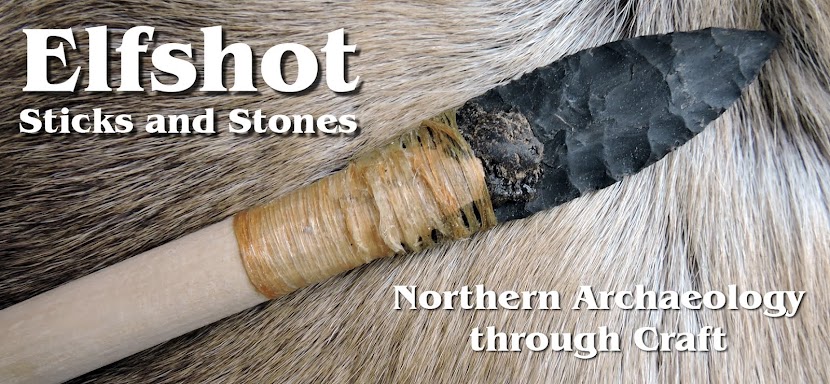 I'm still away in Alberta, but here's a couple more finished reproductions from the Wapusk National Park project. I've been talking about Wapusk National Park and Seahorse Gully kind of interchangeably on this blog and I've since learned that that isn't quite correct. Here's how Karyne at Parks Canada explained it to me:
I'm still away in Alberta, but here's a couple more finished reproductions from the Wapusk National Park project. I've been talking about Wapusk National Park and Seahorse Gully kind of interchangeably on this blog and I've since learned that that isn't quite correct. Here's how Karyne at Parks Canada explained it to me:Seahorse Gully is not actually in Wapusk National Park. It is itself a National Historic Site. Our Arch. sites have yet to be thoroughly examined. Seahorse Gully is 80km west, closer to Churchill, and has been well examined. That is why we chose this
site.
Side Hafted Microblade: Chert, wood, baleen. I've talked a fair bit about side-hafted microblades recently, so I won't go into a lot of detail on this. This was quite a tiny little blade, but it did have a small amount of usewear along on edge, which helped orient it in the haft. I chose baleen for the binding material because I tend to associate it with wood handles because of the Saqqaq artifacts, even though that site is hundreds of miles away and probably hundreds of years earlier than Wapusk. The hafting areas of the other tools in the pre-Dorset collection from Seahorse Gully are quite wide, which is also something that I associate with baleen hafting. Baleen isn't as fine as sinew and doesn't work so well with narrowly notched tools.
 Burin: To be honest I didn't expect this reproduction to be finished when I compared it last week, but I must have got really lucky somewhere, because its probably the closest match out of all the artifacts so far. This particular burin won't be hafted and is meant to show a completely exhausted tool. If this were hafted in a handle it would almost disappear - just that little peak at the top would be sticking out - the rest would be hidden out of sight like the underwater mass of an iceberg. hmm... maybe there's an archaeology conference t-shirt design in there somewhere. In all three photos, the reproduction is shown on the left side of the artifact.
Burin: To be honest I didn't expect this reproduction to be finished when I compared it last week, but I must have got really lucky somewhere, because its probably the closest match out of all the artifacts so far. This particular burin won't be hafted and is meant to show a completely exhausted tool. If this were hafted in a handle it would almost disappear - just that little peak at the top would be sticking out - the rest would be hidden out of sight like the underwater mass of an iceberg. hmm... maybe there's an archaeology conference t-shirt design in there somewhere. In all three photos, the reproduction is shown on the left side of the artifact. A burin is a specialized engraving tool. Normally, in flintknapping you remove flakes from the edge and they travel in towards the middle of the piece. But with burins, the working edge is prepared by removing long flakes straight down the edge of the tool starting from the tip. This creates a square face, alot like the blade of a skate, but with a very sharp tip at the end, like a parrott's beak. When the edge gets dull, you can resharpen the tool by chipping off a new burin spall. They sound harder to make than they are - flakes like to travel along ridges and the edge of a prepared flake or biface makes a great pathway for a flake to follow.
A burin is a specialized engraving tool. Normally, in flintknapping you remove flakes from the edge and they travel in towards the middle of the piece. But with burins, the working edge is prepared by removing long flakes straight down the edge of the tool starting from the tip. This creates a square face, alot like the blade of a skate, but with a very sharp tip at the end, like a parrott's beak. When the edge gets dull, you can resharpen the tool by chipping off a new burin spall. They sound harder to make than they are - flakes like to travel along ridges and the edge of a prepared flake or biface makes a great pathway for a flake to follow.Photo Credits: Tim Rast
Photo Captions:
1: Ventral surface of the burin reproduction (left) and artifact (right)
2: Hafted microblade shown above the Seahorse Gully artifact
3: Dorsal surface of the burin reprodcution (left) and artifact (right)
4: Detail of the burin scar.


No comments:
Post a Comment